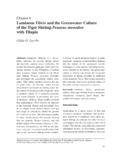Phylogeographic patterns in the Philippine archipelago influence symbiont diversity in the bobtail squid-Vibrio mutualism
- Global styles
- MLA
- Vancouver
- Elsevier - Harvard
- APA
- Help

Download URL
onlinelibrary.wiley.comDate
2018Author
Page views
1,587ASFA keyword
AGROVOC keyword
Taxonomic term
Metadata
Perlihat publikasi penuh
Share
Abstract
Marine microbes encounter a myriad of biotic and abiotic factors that can impact fitness by limiting their range and capacity to move between habitats. This is especially true for environmentally transmitted bacteria that cycle between their hosts and the surrounding habitat. As geologic history, biogeography, and other factors such as water temperature, salinity, and physical barriers can inhibit bacterial movement to novel environments, we chose to examine the genetic architecture of Euprymna albatrossae (Mollusca: Cephalopoda) and their Vibrio fischeri symbionts in the Philippine archipelago using a combined phylogeographic approach. Eleven separate sites in the Philippine islands were examined using haplotype estimates that were examined via nested clade analysis to determine the relationship between E. albatrossae and V. fischeri populations and their geographic location. Identical analyses of molecular variance (AMOVA) were used to estimate variation within and between populations for host and symbiont genetic data. Host animals demonstrated a significant amount of variation within island groups, while symbiont variation was found within individual populations. Nested clade phylogenetic analysis revealed that hosts and symbionts may have colonized this area at different times, with a sudden change in habitat. Additionally, host data indicate restricted gene flow, whereas symbionts show range expansion, followed by periodic restriction to genetic flow. These differences between host and symbiont networks indicate that factors “outside the squid” influence distribution of Philippine V. fischeri. Our results shed light on how geography and changing environmental factors can impact marine symbiotic associations at both local and global scales.
Suggested Citation
Coryell, R. L., Turnham, K. E., de Jesus Ayson, E. G., Lavilla-Pitogo, C., Alcala, A. C., Sotto, F., Gonzales, B., & Nishiguchi, M. K. (2018). Phylogeographic patterns in the Philippine archipelago influence symbiont diversity in the bobtail squid-Vibrio mutualism. Ecology and Evolution , 8(15), 7421-7435. https://doi.org/10.1002/ece3.4266
Type
ArticleISSN
2045-7758Koleksi
- Journal Articles [1256]
Except where otherwise noted, this item's license is described as http://creativecommons.org/licenses/by/4.0/
Related items
Showing items related by title, author, creator and subject.
-
Studies on the efficacy of Sarafin® (sarafloxacin hydrochloride) on vibrios associated with vibriosis in black tiger shrimp (Penaeus monodon)
Pakingking, Rolando V., Jr. ; Lacierda, Erlinda; Torres, James L. (Fish Health Section, Asian Fisheries Society, 2002)
In vitro activity of Sarafin® (sarafloxacin hydrochloride) was determined against 7 luminous Vibrio harveyi isolates and 3 non-luminous Vibrio species (V. parahaemolyticus, V. alginolyticus and Vibrio species) isolated ...
; Lacierda, Erlinda; Torres, James L. (Fish Health Section, Asian Fisheries Society, 2002)
In vitro activity of Sarafin® (sarafloxacin hydrochloride) was determined against 7 luminous Vibrio harveyi isolates and 3 non-luminous Vibrio species (V. parahaemolyticus, V. alginolyticus and Vibrio species) isolated ... -
Occurrence of Vibrio sp. infection in grouper, Epinephelus suillus
Lavilla-Pitogo, Celia R.; Castillo, A. R.; de la Cruz, Margarita C. (Blackwell Publishing, 1992)Vibrio sp., was consistently isolated from grouper, Epinephelus suillus, with bacterial infection. Fingerlings, which were challenged with the bacterium by injection, were highly susceptible. Immersion challenge resulted ... -
Luminous Vibrio and the greenwater culture of the tiger shrimp Penaeus monodon with tilapia
Lio-Po, Gilda D. (John Wiley & Sons, Ltd, 2017)Luminous vibriosis is a devastating infection of penaeid shrimp larvae and juveniles causing heavy mortalities. To counter the bacterial pathogen, Vibrio harveyi, shrimp farmers in the Philippines modified their growout ...






